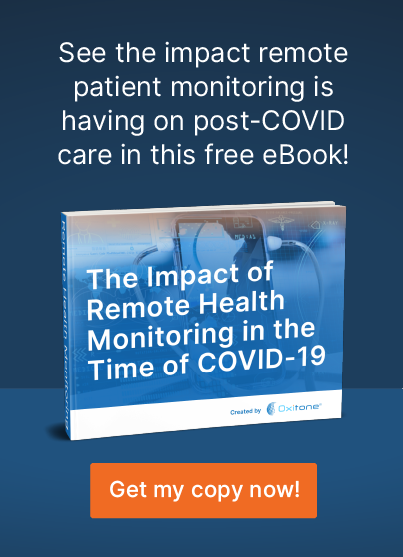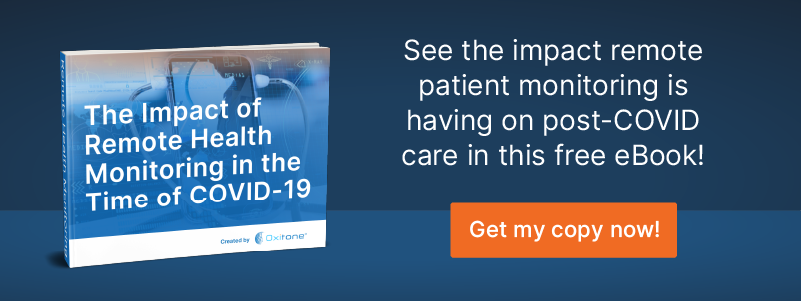The COVID-19 pandemic was unprecedented in its multifaceted impact on the medical system. The world of post-COVID care for patients discharged from the hospital is equally uncharted territory.
Physicians and hospital systems are learning more about what patients need for effective post-COVID care. Certain patients present specialized concerns, such as reducing the risk of readmissions, preventing and addressing “long-haul” symptoms and/or complications, and reducing the cost of care for both patients and healthcare systems.
Thus far, remote patient monitoring (RPM) has played a critical role in addressing these problems. But traditional RPM has limitations in the amount and quality of data that doctors can collect from their patients. Issues like patient compliance can disrupt the ability of RPM to be an effective solution.
Traditional RPM may be limited, but continuous remote patient monitoring (CRPM) has the potential to close the care gap for patients and doctors. Here’s why CRPM is a better alternative to traditional RPM in post-COVID care and how one powerful CRPM device can transform your post-COVID care plan for better results.
The Role of CRPM in Your Post-COVID Care Plan
Post-COVID patients, especially those released from the hospital, have unique healthcare needs. They face the typical risks, such as readmissions and complications, and individualized concerns, such as long-haul symptoms and systemic inflammation.
Due to these needs, RPM plays an essential role in post-COVID care. Doctors need to be able to closely monitor these patients for potential complications without creating an excessive burden that takes away their ability to care for other patients.
RPM is a critical piece of the post-COVID care puzzle. It enables physicians to track key metrics like blood pressure, oxygen saturation, and body weight from afar, and it is linked to better outcomes for patients, including reduced mortality.
These benefits cannot and should not be ignored, but RPM must be done in a way that ensures patient compliance for the most complete and accurate data. Patient compliance results in better care and better insurance coverage, since many companies will not cover post-COVID RPM kits if they are not used more than 50% of the time (defined as sixteen out of every thirty days).
Yet many post-COVID RPM kits come with multiple pieces that may be difficult or complicated for patients to use, reducing the ability of patients to comply with RPM measures. Pieces included in traditional post-COVID RPM kits often include blood pressure cuffs, pulse oximeters, and digital tablets. Medical professionals are given specialized training to use these devices, but patients often are not.
If patients find these kits too complicated or time-intensive to use, they may not keep up with their critical post-COVID care, increasing their risk of experiencing long-haul symptoms, long-term complications, and hospital readmissions. Some populations may be especially likely to experience difficulty with traditional RPM kits, including the elderly and the underprivileged (who may not be used to sophisticated digital technology).
Without patient compliance, the role of RPM is extremely limited in post-COVID care. While it can provide snapshots of patient data, it does not offer the consistency and quality of data needed in order to use these metrics for clinical decision-making. So, how can doctors navigating the post-COVID care landscape improve the quantity and quality of data collected via RPM?
Switching to Continuous RPM with Oxitone
Doctors and hospital systems must consider the diverse technology available to them in today’s digital world and strive to choose the best options for remote patient follow-up care. For post-COVID patients, switching to a single continuous RPM device, instead of complex kits, may present a viable and affordable solution.
CRPM uses advanced medical technology to provide a steady, automated stream of data directly from patients’ bodies, eliminating many of the obstacles associated with traditional RPM. It can improve patient compliance and reduce costs for healthcare systems and providers by eliminating the need to purchase and assemble dozens of pieces for post-COVID RPM kits.
Using a single medical device, such as the wearable CRPM medical device Oxitone 1000M, creates a simpler, more intuitive solution. Oxitone combines all the pieces of a traditional RPM kit, such as pulse oximeters, heart rate, and respiratory rate, into a single wearable interface. Since it is similar to devices that patients are already familiar with, such as digital fitness trackers and remote alarms used in assisted living facilities, it is easy for patients to use correctly, even if they are not used to advanced digital technology.
As long as the patient continues to wear the device, doctors will have access to a steady stream of relevant clinical data, including hypoxia data and COVID screening symptoms. The device sends smart signals to providers only when the data warrants further attention, eliminating the need for doctors to closely monitor patients’ compliance and results during post-COVID RPM.
A single wearable device can improve patient compliance and provide higher-quality data for clinical decision-making. Oxitone also conserves hospital resources and physician attention. As a result, more patients can receive better care. This is especially important because COVID-19 has not eliminated the steady flow of chronic disease patients in private practices, who may have otherwise been neglected in favor of monitoring patients recovering from COVID-19.
Here at Oxitone, we boost value-based healthcare by delivering extraordinary patient, clinical, and economical outcomes at reduced medical utilization and cost. Patients need a prompt response to emergencies. Physicians need an easy and timely follow-up with patients. Our mission is to transform chronic disease management and help save lives worldwide.
Let’s save lives together! To see how we help remote patient monitoring companies and physicians improve the management and care of high-risk patients, contact us today!


